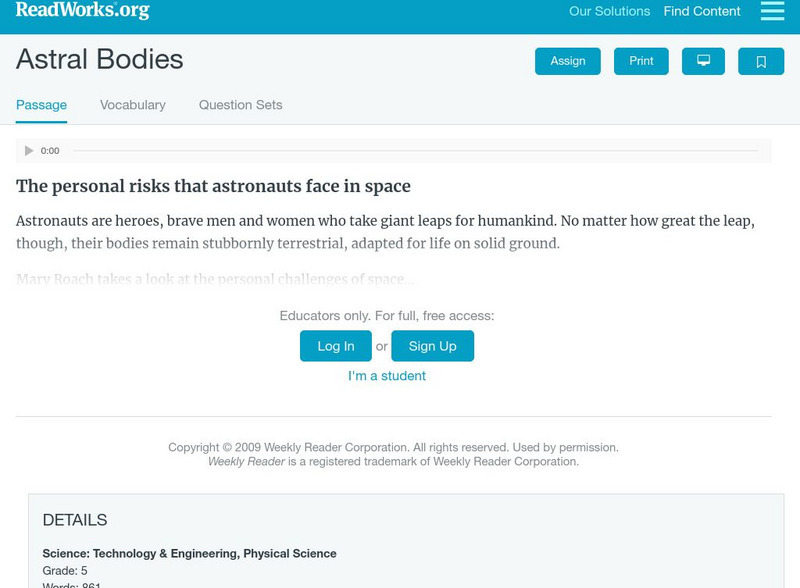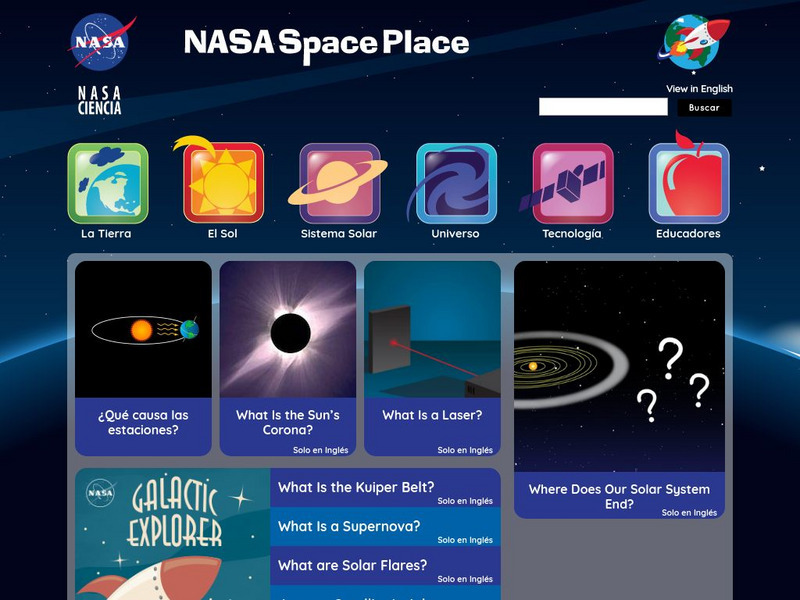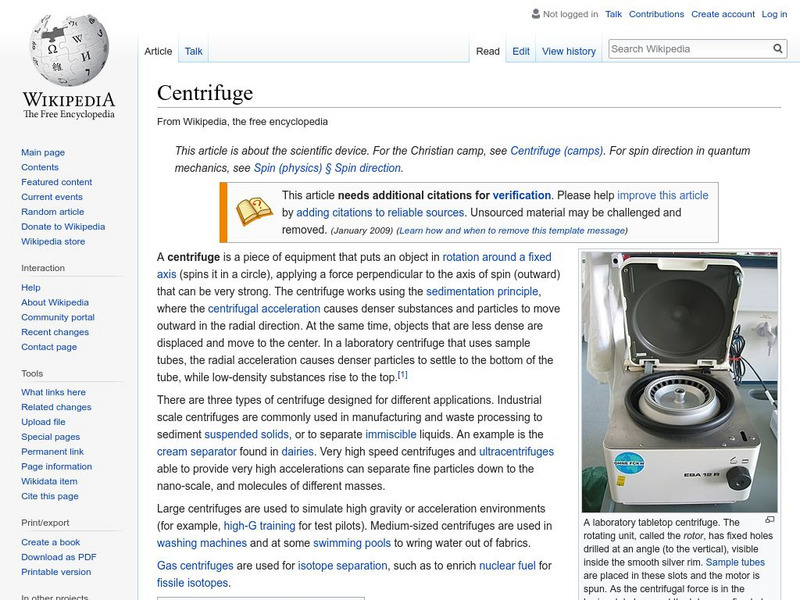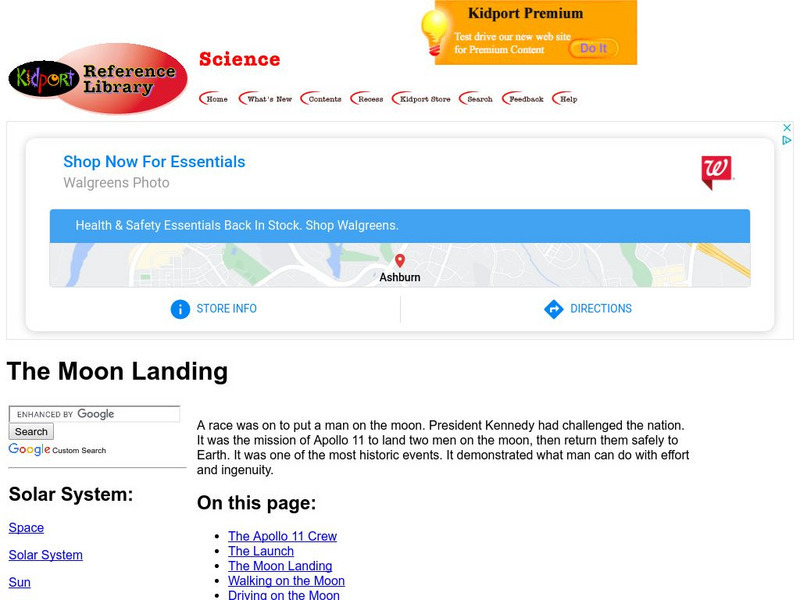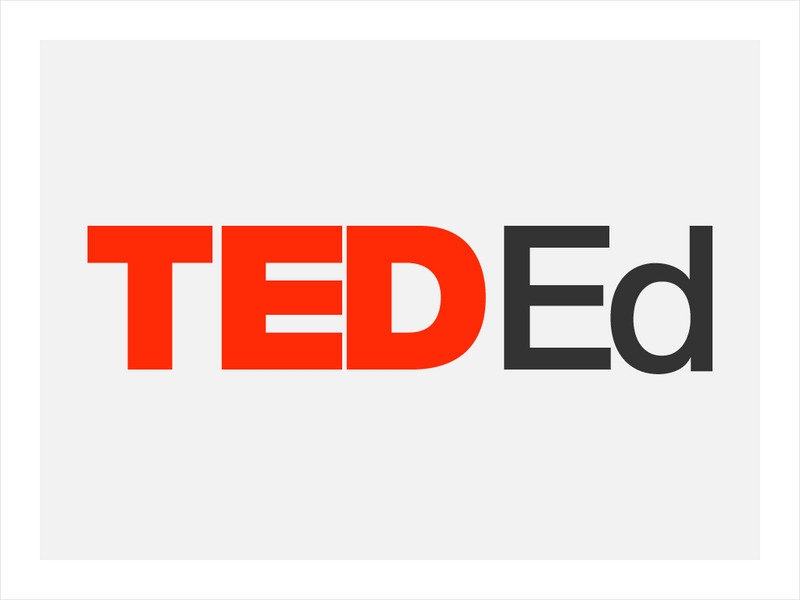Curated OER
#24 Rotating Frames of Reference in Space and on Earth
High schoolers explore rotating frames of reference, focusing on the weightless environment in space and the Coriolis force.
Curated OER
Prepositions and Prepositional Phrases
In these prepositional phrases worksheets, students review the definitions and examples for prepositional phrases, prepositions, and object of prepositions. Students then complete three pages of activities for prepositions.
Curated OER
Mass and Weight
Students explore the science topics of mass and weight. In this mass and weight lesson, students determine the difference between mass and weight as they discuss the definitions and the application the definitions.
Curated OER
Space Facts
Students read space facts and click on the links to research more about space objects. In this space lesson plan, students read about comets, planets, the moon, and more.
TED Talks
Ted: Ted Ed: Gravity and the Human Body
Our bodies function necessarily under the presence of gravity; how blood pumps, a sense of balance and bone growth are all due to life in a world where gravity is an inescapable reality. Armed with experiments from neuroscientists David...
BBC
Bbc Newsround: Astronauts Congratulate Gravity Film From Iss
Article and video report on astronauts aboard the International Space Station offering their congratulations to the film Gravity for its Oscar success.
Read Works
Read Works: Astral Bodies
[Free Registration/Login Required] An informational text about being an astronaut and living in zero gravity. A question sheet is available to help students build skills in reading comprehension.
Physics Classroom
The Physics Classroom: Momentum and Collisions: The Astronaut Catch
Students imagine that they are hovering next to the space shuttle in earth-orbit, and bump into another astronaut of equal mass. If the two astronauts holds onto each other, then how fast do they move after the collision?
TED Talks
Ted: Ted Ed: Free Falling in Outer Space
With a little help from Sir Isaac Newton, Matt J. Carlson explains the basic forces acting on an astronaut during a free fall. [2:59]
PBS
Pbs Learning Media: Newton's Third Law: Action Reaction
An early astronaut's experiences teach students that Newton's third law of motion-for every action, there is an equal and opposite reaction-applies both on Earth and in outer space.
PBS
Pbs Teachers: Stationed in the Stars
Examine the factors that impact an astronaut's freefall in space. Differentiate between zero gravity, weightlessness and freefall.
Bill Nye
Bill Nye: Weightless Clothespin
Try this at-home science experiment to learn that that astronauts fly around in space because they are weightless.
NASA
Nasa Space Place: El Space Place
NASA's space science site for kids - en Espanol. Features a wide range of activities, including games, projects, animations, and more. Also contains useful information on basic physics, chemistry, and other natural sciences, offering...
E-learning for Kids
E Learning for Kids: Science: Indian Ocean: What Are Mass Amd Weight?
Join Maria and Boris the Astronaut in their journey. Learn about mass, weight, and gravity in space.
Khan Academy
Khan Academy: What Is Newton's First Law?
Newton's First Law also called the law of inertia is the most important thing to realize about motion. This article offers more information on motion and explains solved problems involving Newton's First Law. Also included is a video...
Wikimedia
Wikipedia: Centrifuge
Wikipedia provides detailed information and history on centrifuges in scientific research and industry, including its importance in making nuclear weapons.
PBS
Pbs Learning Media: Space Travel
Students are asked to explain why the astronauts in the video are floating and what problems this phenomenon creates for people that travel in space.
Kidport
Kidport: The Moon Landing
Travel back in history and see the first men on the moon. See photos of the crew, the launch, the landing and more.
Kidport
Kidport: The Space Shuttle
Students can see actual photos of a space shuttle launching from earth as well as the people who now could go because of technology. Learn about some of the equipment and vehicles used to make it happen.
TED Talks
Ted: Ted Ed: Candy Corn in Space
Watch NASA astronaut Don Pettit create zero gravity candy corn balls on the International Space Station. [2:57]
Curated OER
Science Kids: Science Images: Eye Tracking Device
An astronaut experiments in gravity free space with an eye tracking device. The complicated equipment rests on the astronauts head as he floats around the shuttle.
Curated OER
Wikipedia: Natl Historic Landmarks in Alabama: Neutral Buoyancy Space Simulator
This structure was built in 1955 to provide a simulated zero-gravity environment in which engineers, designers, and astronauts could perform the various phases of research needed to gain firsthand knowledge concerning design and...
Curated OER
Science Kids: Science Images: Research in Space
This photo shows an astronaut researching in the zero gravity environment of space.








